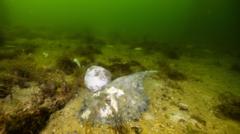The waters of South Australia are facing a severe crisis as a toxic algae bloom is wreaking havoc on the marine ecosystem. This rapid increase in algae, described by the state premier as a "natural disaster," has been expanding since March, now covering an area twice the size of the Australian Capital Territory.
Despite a federal assistance package of A$14 million (about $9 million), the government has not officially classified the bloom as a natural disaster, which would typically trigger a broader response for events like floods or wildfires. Premier Peter Malinauskas emphasized the urgency of the situation, insisting that the algae bloom's consequences, driven by climate change factors such as ocean warming and nutrient pollution, deserve recognition.
Over 400 species of marine life have been reported dead, with local fishermen expressing distress over the impact on their livelihoods. Many have experienced months without income as their catch declines, with one fisherman describing the emotional toll of the situation. The algae bloom, stretching from Coorong to the Yorke Peninsula, has layered the coastline with dead fish and disrupted the environment.
Critics, including Greens Senator Sarah Hanson-Young, argue that if such an environmental disaster were affecting more prominent tourist destinations, the government would react more decisively. Federal Environment Minister Murray Watt acknowledged the situation's seriousness but maintained the bloom doesn't fit the legal criteria for a natural disaster. As the crisis unfolds, both state and federal governments are urged to find effective solutions to combat the devastating effects on both nature and communities.






















